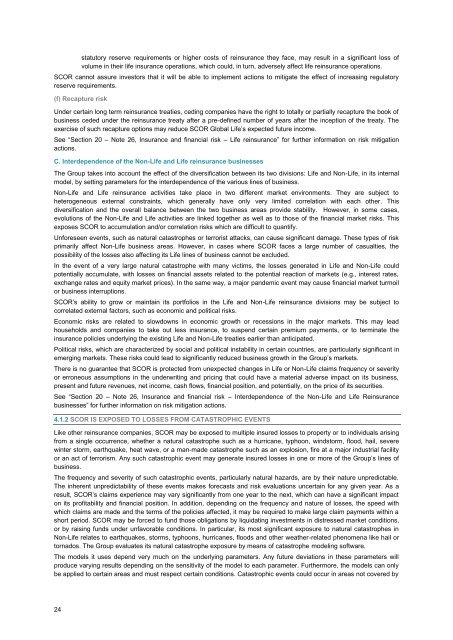4.4 Legal risk - Scor
4.4 Legal risk - Scor
4.4 Legal risk - Scor
Create successful ePaper yourself
Turn your PDF publications into a flip-book with our unique Google optimized e-Paper software.
statutory reserve requirements or higher costs of reinsurance they face, may result in a significant loss of<br />
volume in their life insurance operations, which could, in turn, adversely affect life reinsurance operations.<br />
SCOR cannot assure investors that it will be able to implement actions to mitigate the effect of increasing regulatory<br />
reserve requirements.<br />
(f) Recapture <strong>risk</strong><br />
Under certain long term reinsurance treaties, ceding companies have the right to totally or partially recapture the book of<br />
business ceded under the reinsurance treaty after a pre-defined number of years after the inception of the treaty. The<br />
exercise of such recapture options may reduce SCOR Global Life’s expected future income.<br />
See “Section 20 – Note 26, Insurance and financial <strong>risk</strong> – Life reinsurance” for further information on <strong>risk</strong> mitigation<br />
actions.<br />
C. Interdependence of the Non-Life and Life reinsurance businesses<br />
The Group takes into account the effect of the diversification between its two divisions: Life and Non-Life, in its internal<br />
model, by setting parameters for the interdependence of the various lines of business.<br />
Non-Life and Life reinsurance activities take place in two different market environments. They are subject to<br />
heterogeneous external constraints, which generally have only very limited correlation with each other. This<br />
diversification and the overall balance between the two business areas provide stability. However, in some cases,<br />
evolutions of the Non-Life and Life activities are linked together as well as to those of the financial market <strong>risk</strong>s. This<br />
exposes SCOR to accumulation and/or correlation <strong>risk</strong>s which are difficult to quantify.<br />
Unforeseen events, such as natural catastrophes or terrorist attacks, can cause significant damage. These types of <strong>risk</strong><br />
primarily affect Non-Life business areas. However, in cases where SCOR faces a large number of casualties, the<br />
possibility of the losses also affecting its Life lines of business cannot be excluded.<br />
In the event of a very large natural catastrophe with many victims, the losses generated in Life and Non-Life could<br />
potentially accumulate, with losses on financial assets related to the potential reaction of markets (e.g., interest rates,<br />
exchange rates and equity market prices). In the same way, a major pandemic event may cause financial market turmoil<br />
or business interruptions.<br />
SCOR’s ability to grow or maintain its portfolios in the Life and Non-Life reinsurance divisions may be subject to<br />
correlated external factors, such as economic and political <strong>risk</strong>s.<br />
Economic <strong>risk</strong>s are related to slowdowns in economic growth or recessions in the major markets. This may lead<br />
households and companies to take out less insurance, to suspend certain premium payments, or to terminate the<br />
insurance policies underlying the existing Life and Non-Life treaties earlier than anticipated.<br />
Political <strong>risk</strong>s, which are characterized by social and political instability in certain countries, are particularly significant in<br />
emerging markets. These <strong>risk</strong>s could lead to significantly reduced business growth in the Group’s markets.<br />
There is no guarantee that SCOR is protected from unexpected changes in Life or Non-Life claims frequency or severity<br />
or erroneous assumptions in the underwriting and pricing that could have a material adverse impact on its business,<br />
present and future revenues, net income, cash flows, financial position, and potentially, on the price of its securities.<br />
See “Section 20 – Note 26, Insurance and financial <strong>risk</strong> – Interdependence of the Non-Life and Life Reinsurance<br />
businesses” for further information on <strong>risk</strong> mitigation actions.<br />
4.1.2 SCOR IS EXPOSED TO LOSSES FROM CATASTROPHIC EVENTS<br />
Like other reinsurance companies, SCOR may be exposed to multiple insured losses to property or to individuals arising<br />
from a single occurrence, whether a natural catastrophe such as a hurricane, typhoon, windstorm, flood, hail, severe<br />
winter storm, earthquake, heat wave, or a man-made catastrophe such as an explosion, fire at a major industrial facility<br />
or an act of terrorism. Any such catastrophic event may generate insured losses in one or more of the Group’s lines of<br />
business.<br />
The frequency and severity of such catastrophic events, particularly natural hazards, are by their nature unpredictable.<br />
The inherent unpredictability of these events makes forecasts and <strong>risk</strong> evaluations uncertain for any given year. As a<br />
result, SCOR’s claims experience may vary significantly from one year to the next, which can have a significant impact<br />
on its profitability and financial position. In addition, depending on the frequency and nature of losses, the speed with<br />
which claims are made and the terms of the policies affected, it may be required to make large claim payments within a<br />
short period. SCOR may be forced to fund those obligations by liquidating investments in distressed market conditions,<br />
or by raising funds under unfavorable conditions. In particular, its most significant exposure to natural catastrophes in<br />
Non-Life relates to earthquakes, storms, typhoons, hurricanes, floods and other weather-related phenomena like hail or<br />
tornados. The Group evaluates its natural catastrophe exposure by means of catastrophe modeling software.<br />
The models it uses depend very much on the underlying parameters. Any future deviations in these parameters will<br />
produce varying results depending on the sensitivity of the model to each parameter. Furthermore, the models can only<br />
be applied to certain areas and must respect certain conditions. Catastrophic events could occur in areas not covered by<br />
24
















